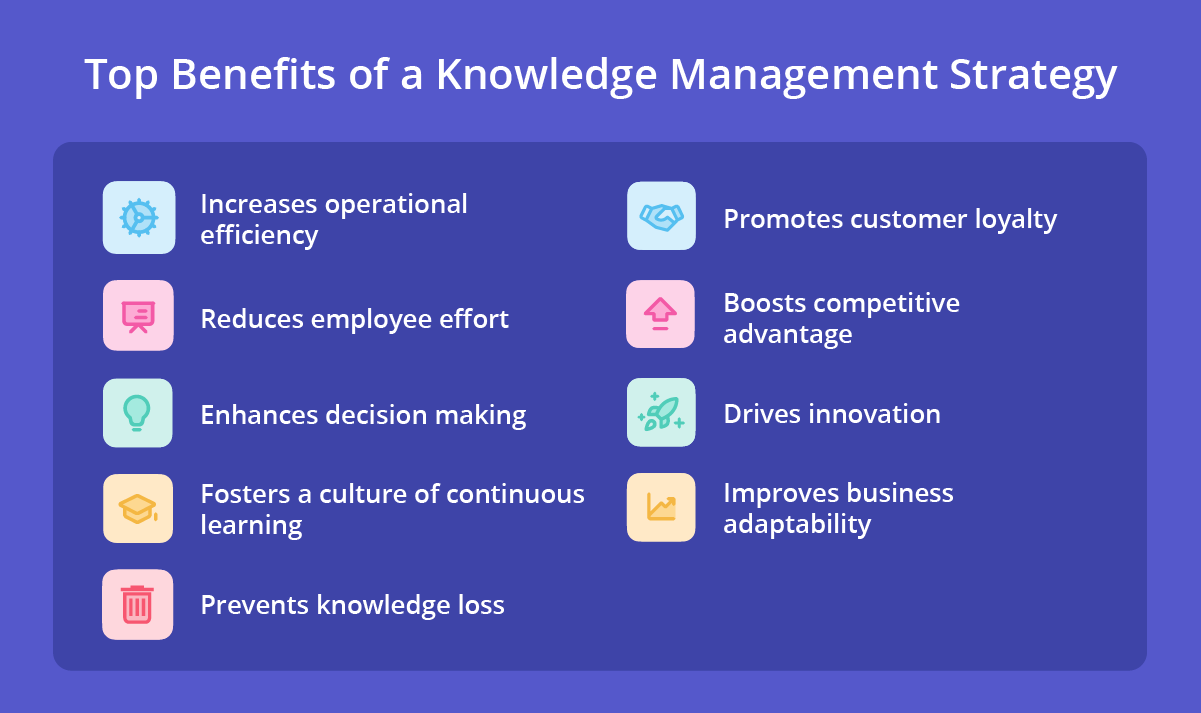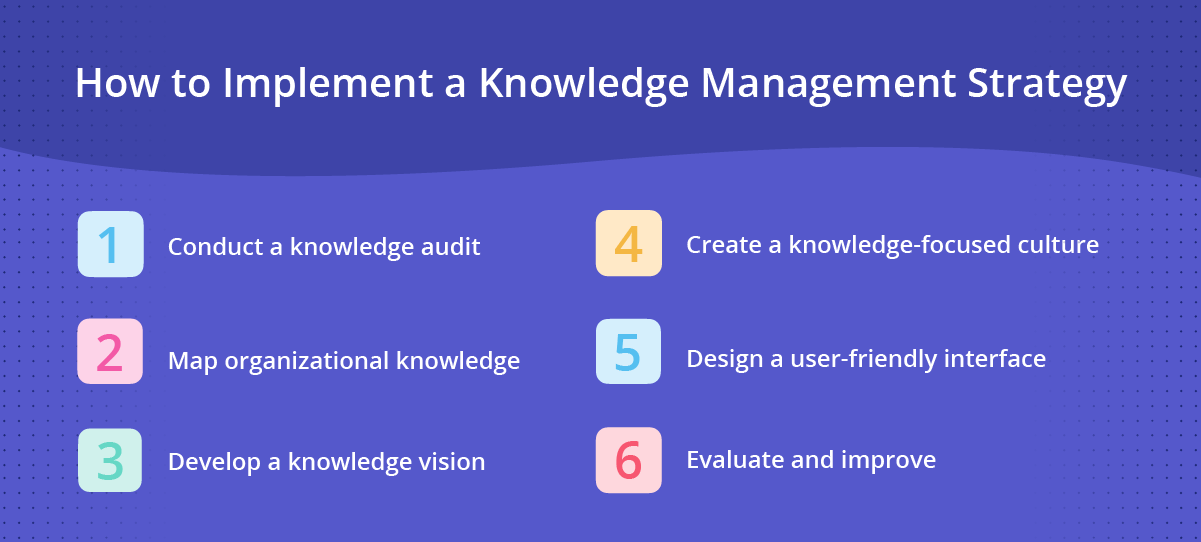How to Implement an Effective Knowledge Management Strategy

Key Takeaways
- Knowledge strategy provides a framework for acquiring, storing, sharing, and utilizing knowledge to boost employee productivity and decision-making.
- Types of strategies—IT, personalization, codification, and knowledge creation—allow organizations to tailor their approach based on culture and business needs.
- Core elements include knowledge creation, storage, dissemination, application, and monitoring to ensure continuous improvement.
- Implementation steps: conduct a knowledge audit, map processes, develop a knowledge vision, foster a knowledge-focused culture, design the KMS, and evaluate and refine regularly.
- An effective knowledge management strategy enhances operational efficiency, innovation, customer loyalty, adaptability, and competitive advantage.
An effective knowledge management strategy refers to a detailed plan of action to improve the way knowledge is acquired, stored, managed, and utilized within an organization. It is a strategic tool that can increase employee productivity by at least 20% through communication, dissemination, and preservation of knowledge within the organization.
The bottom line is about harnessing insights to drive innovation, workflow efficiencies, and competitive advantage. Achieving these requires a clear and extensive understanding of the corporation's knowledge assets, communication channels, and culture.
A knowledge management strategy, similar to a knowledge governance strategy, is essential for modern corporations aspiring to capitalize on their knowledge assets and foster a culture that encourages continuous learning and growth. Paying heed to this tactic can provide businesses with a robust framework to stay competitive, agile, and innovative in the ever-evolving global marketplace.
What is a knowledge management strategy
A knowledge management strategy, by its fundamental definition, is essentially an approach to the identification, creation, storage, sharing, and utilization of an organization's knowledge resources. Its primary objective is to ensure that knowledge is accessible, transferable, and effectively utilized to improve operational procedures and boost employee productivity.
At its core, a knowledge management strategy is a structured blueprint for managing an organization's intellectual assets and the knowledge contained within its people. This meaning invariably underlines the importance of a well-crafted knowledge management strategy in enhancing the decision-making abilities of an organization, boosting its competitive edge, and driving long-term sustainability.
A robust knowledge management strategy would generally encompass several components including strategic goals, knowledge audit, knowledge acquisition and creation, knowledge storage and retrieval, and finally, knowledge distribution and application. Each of these components plays a unique role in building and implementing a successful knowledge management strategy.
Understanding what constitutes effective knowledge management and its principal components is the first critical step toward achieving organizational success in today's competitive landscape.
The importance of a knowledge management strategy
A knowledge management strategy is a vital component in today's dynamic business world. It can be the deciding factor between a thriving business and one that struggles to keep up with the competition. A knowledge management strategy is important for both employees and customers and in defining the success of a business.
For employees
Employees thrive in an environment where knowledge is shared freely and easily accessed, with 81% frustrated by not being able to access knowledge as they spend an average of 1.8 hours per day searching and gathering information. When an effective knowledge management strategy is in place, every team member has access to the same valuable information. This diminishes the risk of a silo mentality and fosters collaboration.
In essence, it enables employees to learn from each other’s experience, fostering organizational learning and promoting a culture of continuous improvement. Knowledge is what aids in problem-solving, innovating, and making informed decisions. Therefore, a robust knowledge management strategy is essential for employee productivity and engagement.
For customers
Customers, too, stand to gain from an effective knowledge management strategy. When employees are equipped with a wealth of knowledge, this invariably translates into better customer service. Knowledgeable employees can address customer needs and queries more effectively, thus fostering customer trust and loyalty. Furthermore, the shared knowledge can be used to understand and anticipate customer needs, leading to the creation of superior products or services.
For organizations
From a broader perspective, knowledge management strategies are paramount for organizations as a whole. These strategies provide a competitive advantage, as they facilitate the creation of unique and valuable insights derived from the collective knowledge of the organization. In turn, these insights can lead to innovation, efficient problem-solving, and better decision-making. It magnifies the organization's capacity to adapt to external changes and disruptions, transforming it into a learning organization, thus ensuring its long-term sustainability.
4 types of knowledge management strategies
Understanding the different types of knowledge management strategies lays the groundwork for assessing and implementing an effective knowledge management system in an organization. Essentially, knowledge management strategies aim to extract, format, and share the considerable volume of knowledge that resides within an organization, to maximize its value, foster innovation, boost performance, and give a competitive edge in the business arena.
Information technology strategy
One common type of knowledge management strategy is the information technology strategy. This approach seeks to construct and utilize technology infrastructure such as knowledge management automation to capture, store, and disseminate knowledge across the organization. It focuses on creating electronic databases, collaborative software, and knowledge-sharing platforms that help streamline the sharing and application of knowledge. Industries that rely heavily on technology, like IT firms or software development companies, commonly adopt this strategy.
Personalization strategy
Another type includes the personalization strategy. Rather than relying solely on technology, this strategy emphasizes the sharing of tacit knowledge - that is, knowledge embedded in people's minds. Personalization strategies center around facilitating interactions and connections between employees which can prompt the sharing of individual expertise and know-how. It typically finds application in consultancy firms or research institutions where experiential knowledge is valuable.
Codification strategy
Leveraging a codification strategy represents an alternative method where knowledge is meticulously documented, structured, and stored for easy retrieval. An emphasis is placed on capturing explicit knowledge in a format that can be easily accessed and understood by various members of the organization. Libraries, law firms, or large corporations often use this strategy to manage large quantities of information.
Knowledge creation strategy
Conversely, the knowledge creation strategy involves actively encouraging innovation and original thought. This strategy seeks to foster a culture and environment where new ideas, innovations, and wisdom can germinate. Tech startups and creative industries can particularly benefit from this strategy.
In essence, a variety in knowledge management strategies means there is an effective approach for any company or industry, ranging from financial services to retail. The choice of strategy depends on the organization's nature, culture, and business priorities. By identifying the most appropriate strategy, companies can utilize their intellectual assets fully, promoting operational efficiency and strategic advantage over competitors.
Top benefits of a knowledge management strategy
Successful businesses around the globe comprehend and harness the wealth of knowledge present within their organizations. A meticulously planned and efficiently executed knowledge management strategy can extract immense value, benefiting an organization in a multitude of ways.

Increases operational efficiency and reduces employee effort
The consolidation of collective knowledge eliminates redundant effort, promoting efficiency within the organization. Employees no longer need to 'reinvent the wheel,' allowing them to focus their efforts on new prospects and challenges. This consolidation not only streamlines processes but also prevents employees from making the same mistake twice by ensuring lessons learned are shared.
Enhances decision making
A knowledge management strategy enhances decision-making. Armed with the right knowledge at the right time, managers can make informed decisions that align with the company's objectives, reducing risks and uncertainty.
Fosters a culture of continuous learning
It cultivates an environment of continuous learning and innovation, fostering employee growth and organizational advancement. A knowledge management strategy turns the workplace into a conducive learning setting where skill sets are continuously enriched.
Prevents knowledge loss
A knowledge management strategy ensures the retention of intellectual capital. As employees leave, retire, or get promoted, critical knowledge can be lost. Yet, with an effective strategy, this knowledge is retained and easily transferred, providing continuity in crucial roles.
Promotes customer loyalty
A knowledge management strategy can prove instrumental in client relationship management. By understanding the needs, preferences, and concerns of clients, an organization can personalize its offerings to resonate with clients, promoting loyalty and repeat business.
Boosts competitive advantage
An effective strategy can enhance an organization's competitive advantage. By optimally utilizing its knowledge assets, an organization can outpace competitors in innovation, customer relations, and operational efficiency.
Drives innovation
A knowledge management strategy can drive creativity and innovation. A knowledge-focused environment promotes the sharing of different perspectives and ideas, providing fertile ground for innovation.
Improves business adaptability
An effective strategy improves adaptability. As markets evolve and technologies advance, companies with knowledge management strategies can adapt and redefine processes faster, ensuring their survival and growth in the rapidly changing business landscape.
Key elements of a knowledge management strategy
A knowledge management strategy is an intricate aggregation of activities and protocols that help an organization generate, preserve, share, and apply knowledge efficiently and effectively. There exist five integral elements or components of a robust knowledge management strategy.
Knowledge creation
The knowledge creation aspect concerns the ability to develop and innovate new insights, ideas, and perspectives using organizational networks. Motivating teams to brainstorm effectively and instigate critical and creative thinking processes can anchor this component.
Knowledge storage
Next comes knowledge storage, a feature that's invariably about preserving and cataloging organizational knowledge. This armor of information could be explicit or tacit knowledge.
Knowledge dissemination
Knowledge dissemination is made achievable by distributing and sharing valuable knowledge across the organization. Through an intranet, newsletters, or regular training sessions, companies ensure that the spread of knowledge is omnipresent, increasing collective competence.
Knowledge application
An integral element is knowledge application, which means putting gathered knowledge into practical use. Companies must continually analyze how knowledge is employed in daily operations and decision-making.
Knowledge monitoring
Lastly, knowledge monitoring plays a pivotal role in measuring the effectiveness of the knowledge management strategy. Metrics and KPIs to assess knowledge usage, its benefits, and methodology are crucial.
Each element discussed above is of equal importance and collectively forms a formidable knowledge management strategy. All these components, when implemented in harmony, can lead to sustainable organizational growth and competitive advantage.
Implementing a knowledge management strategy
A knowledge management strategy is designed to leverage an organization's intellectual capital to generate derivative benefits, primarily in terms of delivering value to customers consistently. Here are the 6 steps organizations need to take to implement an effective knowledge management strategy.

Conduct a knowledge audit
For companies aiming to create an effective knowledge management strategy, it begins by conducting a comprehensive knowledge audit. The knowledge audit is a precursor to developing a knowledge management strategy, as it gives an accurate reflection of the current state of knowledge within the organization. This step includes identifying what knowledge exists, where gaps are, and what forms knowledge takes, enabling the organization to take steps toward managing and optimizing this vital resource.
Map organizational processes
After conducting a detailed knowledge audit, mapping the organization's processes is the next essential step. This process involves charting the acquired knowledge, attributing it to its source, and highlighting its relevance, enabling effective management and utilization. By mapping knowledge, companies can distribute it efficiently across different teams and departments, minimizing information silos and enhancing collaboration.
Develop a knowledge vision
Once the foundation has been laid with thorough knowledge audit and mapping, the next crucial step is to develop a knowledge vision. The organization needs to clarify its aims and aspirations for knowledge management, ranging from improving customer service to accelerating employee proficiency. This vision serves as the guiding principle in developing a knowledge management strategy, creating a pathway that aligns all employees towards the same objective.
Create a knowledge-focused culture
Following the development of the knowledge vision, the next step is to create a knowledge-focused culture. This includes promoting a culture that values knowledge-sharing, learning, and collaboration. Fostering a culture that encourages idea and information exchange helps in shaping the knowledge management strategy effectively. This cultural shift may involve organizational changes, updated employee training programs, adjusted performance evaluations, and even modifications in the communication paths.
Design the knowledge management system
The fifth step involves designing and implementing the knowledge management system itself, incorporating all the data acquired through audits and maps, and aligning it with the knowledge vision. This step may involve creating new knowledge repositories, improving information accessibility, and fostering the habit of knowledge codification. It is essential during this stage to ensure the mechanism is user-friendly, secure, and efficient to enhance adoption and use by employees.
Evaluate and improve the knowledge management strategy
The last step, but a continuous one, is evaluating and improving the knowledge management strategy. Once the strategy is implemented, revisit the system periodically to assess its effectiveness and identify areas of improvement. Robust tracking and measuring with operational reports should be in place to monitor the strategy's performance against the established goals. This evaluation helps in determining the return on investment.
The successful implementation of a knowledge management strategy doesn't happen overnight. It's a long-term commitment that involves ongoing evaluation and refinement. However, with a calculated approach that involves thorough knowledge auditing, effective mapping, goal-specific vision creation, a culture shift towards knowledge sharing, careful system design, and constructive evaluation, implementing a knowledge management strategy can yield immense benefits for organizations. The key lies in recognizing that knowledge is power and harnessing it can unlock the organization's potential.
Getting started with a knowledge management strategy
The road toward developing a knowledge management strategy is a labor-intensive and continuous process that requires commitment. It is a journey that involves understanding the organization's knowledge needs, gathering and disseminating that knowledge, setting up processes to ensure its effective utilization, and then continually examining and refining these processes. Organizations willing to invest time and resources in the management of their knowledge will significantly observe improved outcomes.
Visit our features page to learn more about how the strategic implementation of a knowledge management strategy is extremely beneficial in fortifying operations, making informed decisions, and eventually driving organizational growth and success.


